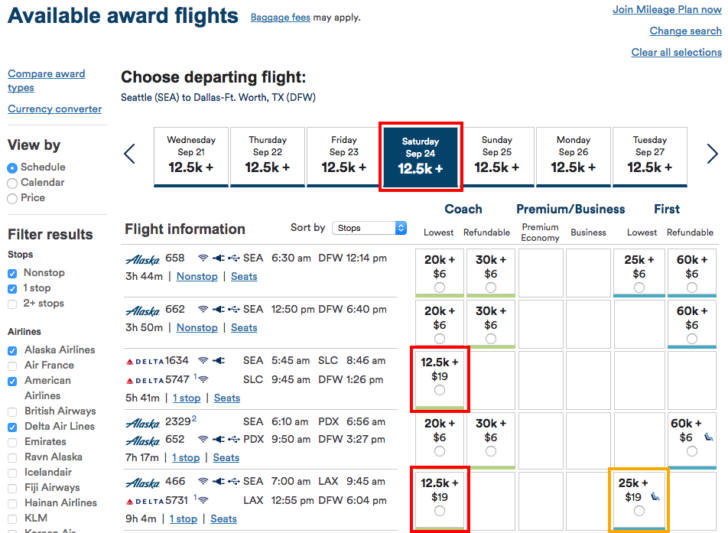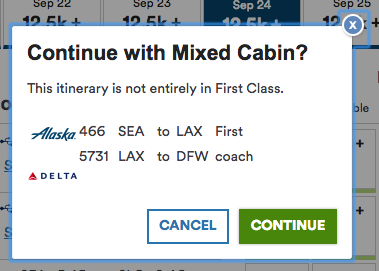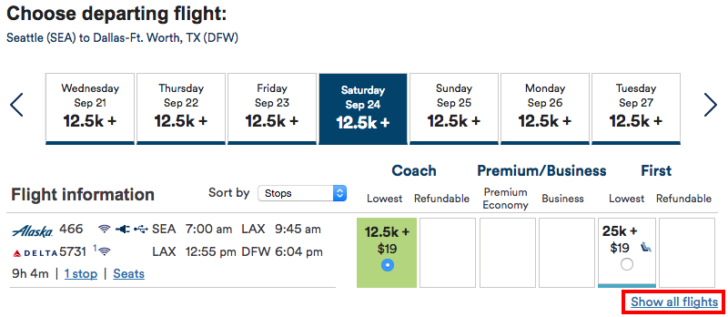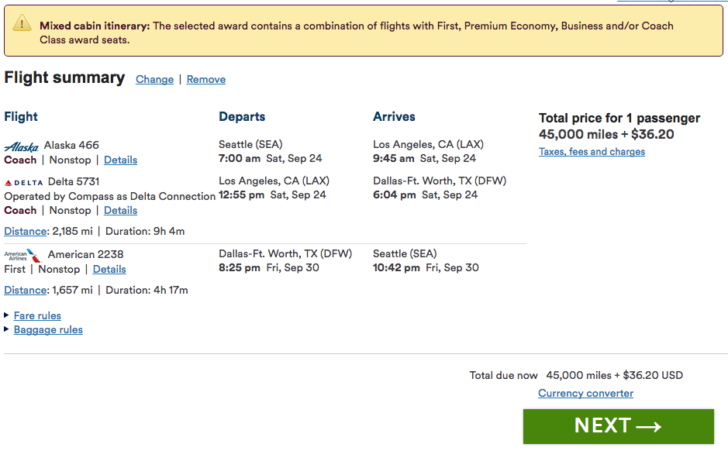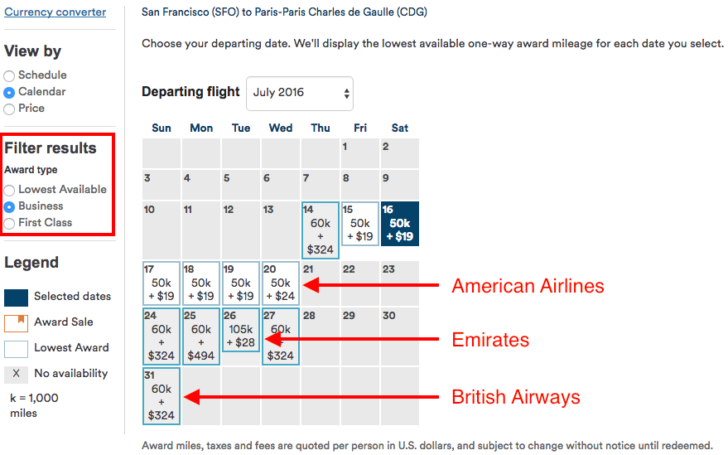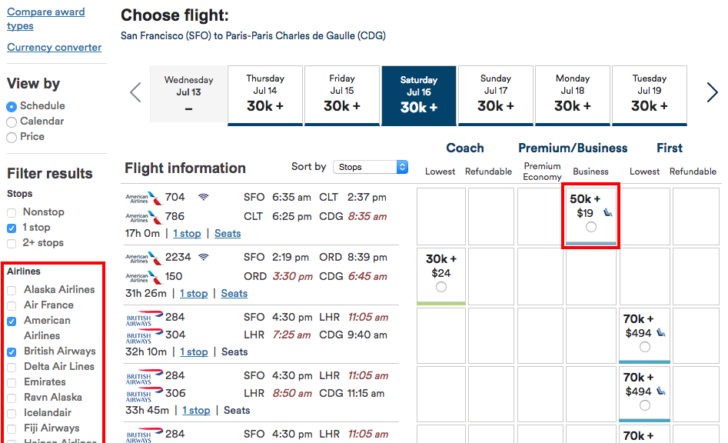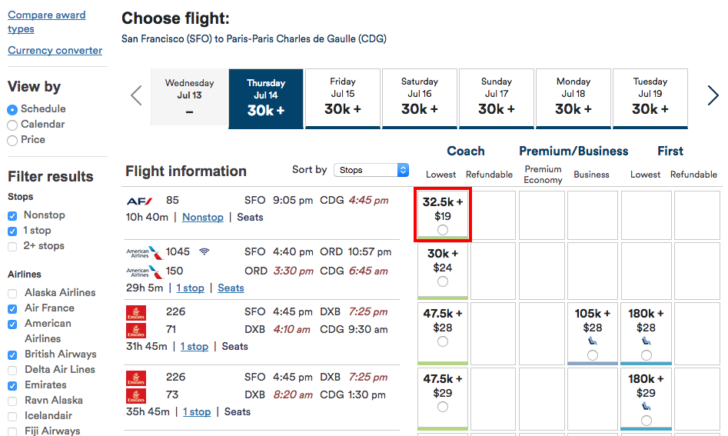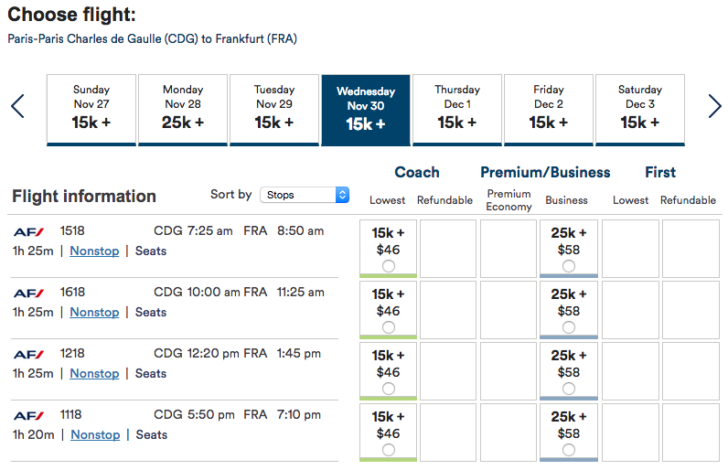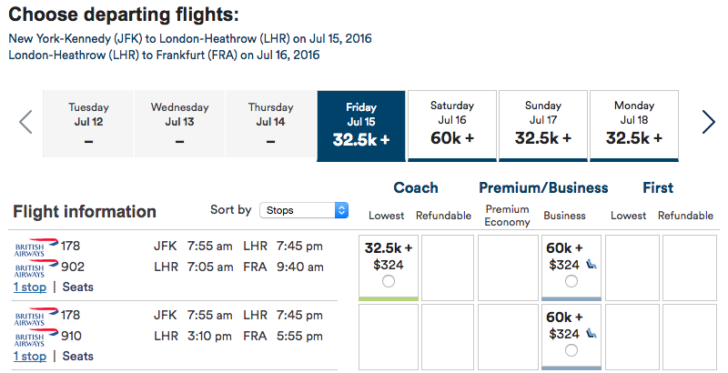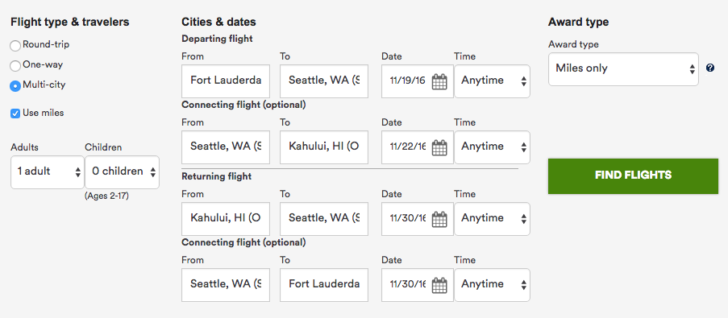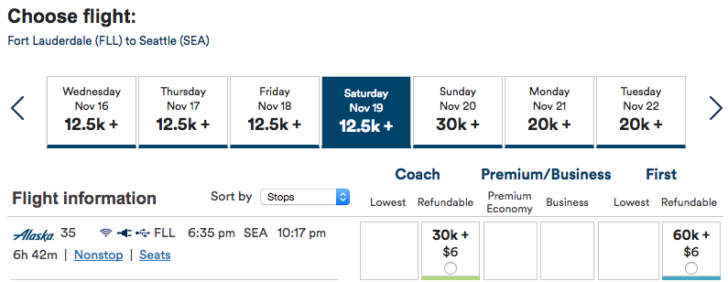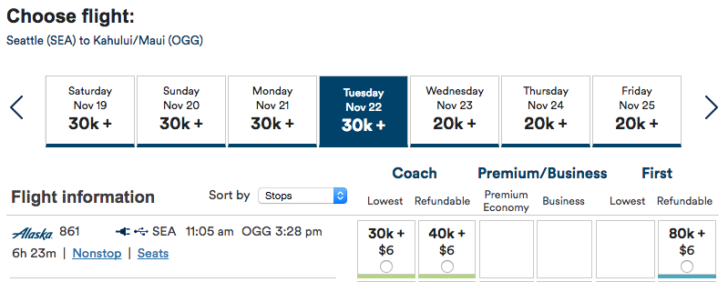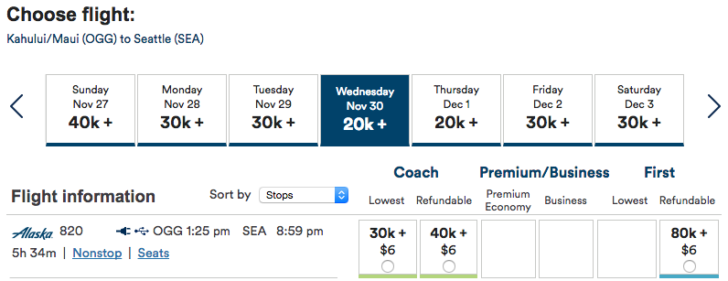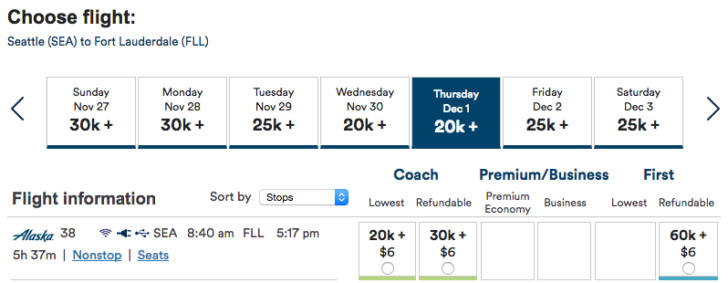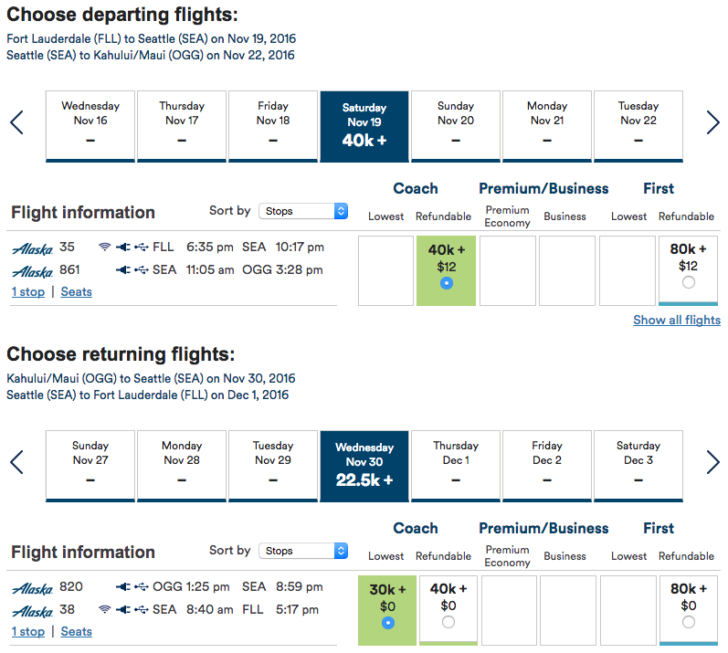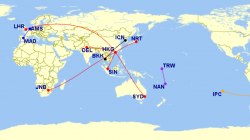Alaska Airlines’ unique award routing rules can present challenges when trying to find award inventory. Most airlines have an award chart that covers the entire globe, but Alaska has a very specific award chart that only covers specific routes. Most airlines let you mix and match carriers, but Alaska only allows one partner airline in each direction. Together these two rules can create situations where no complete itinerary is returned even if individual flights have space available.
Mileage Plan has 17 partners, including American Airlines and Delta Air Lines as well as a mix of other international carriers. Although not a member of any alliance, this does enable you to use your Alaska miles to reach most destinations. Note that Cathay Pacific and LAN, two popular partners, cannot be booked online. You’ll need to search somewhere else — such as the British Airways website — to find availability and then call Alaska to book. (Aeromexico is also a partner, but it’s no longer possible to redeem miles on their flights.)
- Alaska Airlines
- Air France
- American Airlines
- British Airways
- Cathay Pacific
- Delta Air Lines
- Emirates
- Fiji Airways
- Hainan Airlines
- Japan Airlines
- Icelandair
- KLM
- Korean Air
- PenAir
- Qantas
- Ravn Alaska
I recommend using the Alaska Airlines website only when trying to book an award flight operated by Alaska Airlines or Horizon Air, or for a few select partners that are relatively easy to find. In most cases you would be better served using another website to search and then calling Alaska Airlines to book.
Still, that doesn’t mean I should leave you hanging. There are some useful tricks to using the Alaska website that can greatly improve your chances of success. And, as I said, it is still very useful for booking travel on some carriers.
Table of Contents and Related Posts
- Compare Award Prices from Different Loyalty Programs
- Introduction to Alaska Mileage Plan Awards
- Find Award Space on the Alaska Airlines Website
- Find Award Space on the American Airlines Website
- Find Award Space on the British Airways and Qantas Websites
- Find Award Space Using ExpertFlyer (coming soon)
- Alaska Mileage Plan Routing Rules
- Alaska Mileage Plan Fees and Surcharges
Booking a Typical Domestic Itinerary
This first example is for a simple round-trip itinerary from Seattle to Dallas. I chose it specifically because, though Alaska provides non-stop service, there are also several other airlines that provide non-stop or connecting flights. Understanding how to use Alaska’s website to find and filter partner awards is ultimately the most useful skill you’ll learn from this post.
After entering cities and dates, I also checked the box on the left to “use miles.” Don’t worry about the “Award type” dropdown menu on the right. The only other options are Miles & Money awards, which tend to be a bad deal because they offer only 1 cent per point. You can usually use your miles to get greater value if you book a traditional award ticket, and I value my Alaska miles at 2 cents each. If you can’t get 2 cents per mile, I recommend you save your miles for another flight and pay all cash instead.
The first page you see is full of information. Detail is both Alaska Mileage Plan’s greatest strength and its greatest weakness. There is so much information that it can be overwhelming to people who aren’t familiar with it.
First, notice that the calendar ribbon along the top displays the lowest award on any particular day. This can be helpful for finding flights on a specific carrier, as I’ll get to later. But even more interesting is that if you look in the “Coach – Lowest” column on the far left of the results, not every award is the same price. Some flights are 20,000 miles, others are 12,500 miles, and it doesn’t really seem to matter if you’re flying on Alaska Airlines or one of its partners. I’ve highlighted two examples of the absolute lowest price in red.
If you’re flying entirely on Alaska Airlines, the “lowest” award actually has multiple prices and any of them can be in this column.
- Alaska Airlines has two different awards depending on demand. Both have limited availability, but it allows them to offer a little more space for a few more miles, rather than raising the price all the way for an unrestricted, “refundable” award.
- Every partner airline has its own price. Some of them are the same and some are different. Just know that you can’t assume the same price applies to every partner on the same route.
For these reasons, I think it is very important that you review the award chart before you begin searching for award space. Take a look at what the cheapest award is for each carrier so you can compare the results to that baseline. Sometimes one partner will be offer a lower price than another.
The other thing to pay attention to is the risk of a mixed cabin award, which I’ve highlighted in orange in the above figure. If an award includes multiple flights in different cabins, you’ll still have to pay the first or business class price for the entire trip. This is indicated with a little blue seat icon, and when you select it you will see a pop-up box warning you of the mixed itinerary.
Mixed cabins may not bother you if the short flight is in coach and the long flight is up front. However, sometimes the reverse is true. No one wants to pay for an international first class award when you’ll be spending the majority of your time in the back of the bus.
One thing I do like about Alaska Airlines is that after you pick a flight for the outbound journey, the return journey is right below it on the same page. The page doesn’t need to reload. If you need to go back, you can just scroll up and click on “Show all flights” to expand the menu again.
Once you’ve selected flights for both halves of your round-trip itinerary, you can review the details and continue with the booking process. In this case, I’ve chosen an outbound flight that includes travel on Delta Air Lines and a return flight with travel on American Airlines. I can combine two partners in the same reservation, but they must be in different directions. I could not, for example, fly Delta and American on the outbound journey.
The fees are also a little higher than you might be used to. Alaska Airlines charges a mandatory $12.50 fee for each direction when you book a partner award. This fee is non-refundable, even if you cancel your award, redeposit the miles, and get other fees and taxes returned to you. It will apply if you book online or if you book by phone.
On the other hand, Alaska Airlines does allow free changes and cancellations up to 60 days before departure, even on partner awards. Most airlines aren’t so generous. Because this award is for travel on September 24, I have up until July 27 to make free changes; after that it will cost $125 per person to change or cancel the award.
These are the basics of searching for and booking award travel through Alaska Airlines. Now I’ll cover some more complex topics.
Using the Award Calendar to Find Partner Flights
I don’t normally use the award calendar if I know which dates I want to travel. However, it can be useful if your dates are flexible and you are interested in traveling on a specific carrier — perhaps one that flies nonstop between two cities.
In this example I’m now looking for a flight on Air France between San Francisco and Paris, and for convenience I’ve changed it to a one-way award. I also checked the box at the bottom to use the award calendar. (You can always do this after the fact.)
The award calendar is useful for finding awards on a specific airline because it shows the cheapest price on every day of the month that has availability. Remember to filter the results for the desired cabin class, and then look at the calendar.
As I said before, each partner has its own price for the same route. In this case I know from looking at the award chart that American Airlines charges 50,000 miles to travel between the United States and Europe, so that’s probably American Airlines award space from July 15 through July 20. I also know that Emirates charges 105,000 miles for the same route, so I’m betting that’s what I see on July 26.
I’m looking for Air France, which charges 60,000 miles, and there are a few dates that list an award for 60,000 miles. However, all of those dates have high fees of $300 or more. That’s a clear sign that this award is actually offered by British Airways, which charges the same number of miles but higher fees than Air France. Other airlines that tend to have higher fees include Hainan Airlines (about $170) and Icelandair (about $130).
When I select July 16, which lists 50,000 miles and $19 as the cheapest award, it turns out that American Airlines is at the top of the results — just as I predicted.
Now, it’s important to remember that just because a particular airline is the cheapest on a given day doesn’t mean that it is the only option. This same date with an inexpensive first class award also has flights operated by British Airways, but at a higher price. You can filter through multiple airlines by checking the boxes on the left. Unfortunately there’s no way to filter airlines on the calendar.
Fortunately non-stop flights do sort to the top by default. That means if I know that Air France is the only nonstop option (or one of a few nonstop options) then I will see it right away when looking on other dates. On July 14, for example, it’s available — but only in coach.
I would dearly love to see Alaska Airlines create a feature to do a calendar search for a specific airline. My hack isn’t foolproof, and some of you may think it’s not useful at all. I do think it’s at least a little helpful. If I’m looking for a 60,000-mile award on Air France, I can at least exclude those dates where more expensive awards on Emirates and British Airways are the cheapest option.
Does Your Award Exist?
I next want to address the frustrations some people face when they get an error message. Is it because your award doesn’t exist, or is it because you aren’t searching for it properly? As we saw above, it can be extremely difficult to search an award on some carriers because of limited availabilty. Air France does operate a flight from San Francisco to Paris, but we only found one date and it wasn’t in the desired cabin class.
But that’s not Alaska’s fault. Air France is just stingy. There are tons of flights available between Paris and Frankfurt, an intra-Europe route with more plentiful availability.
Okay, great! Short flights like this tend to have more award space. What if we were coming from London instead? I’ll search again for a flight from London to Frankfurt.
Hmmm. Well, now you’re starting to learn about the frustrations of Mileage Plan. Each partner, in addition to having its own award price, also has its own eligible routes. Not every route has a price associated with it. Intra-Europe awards can be booked with Air France, but they can’t be booked with British Airways — at least not by themselves. It’s perfectly okay to book an intra-Europe flight with British Airways as long as it’s a continuation of a transatlantic journey. I searched again for a flight from New York to Frankfurt, and the intra-Europe leg showed up just fine.
Again, become familiar with the Alaska Airlines award charts before you begin your search. Many people have become frustrated because they want to book just one small flight and they can’t unless it’s part of a longer itinerary. But it’s also wrong to assume you must start in the United States. I’ve actually written an entire post on these international exceptions — intra-Asia first class on Cathay Pacific is one of my favorite examples and is far cheaper with Alaska than most competing programs.
Creating Multi-City Itineraries and Stopovers
The last useful trick I know is how to create complex itineraries that involve stopovers or connections in specific cities. A stopover is a connection for longer than 24 hours — perhaps even days or weeks — and are one of the strongest features of the Mileage Plan program. Alaska Airlines allows a free stopover on most one-way awards, even within the United States, and two stopovers on round-trip awards. To book a stopover, check the “multi-city” button the front page.
Let’s assume my brother is flying out from Florida, and I want him to pass through Seattle so we can spend a few days before we both travel onward to Hawaii. I’ve built in a gap of a few days on the outbound flight; he’ll connect right away on the return.
If I perform this search all at once, I’ll get a negative result. Remember that I said Alaska displays all the results on one page so you don’t have to refresh after each selection. This also means one bad apple spoils the barrel.
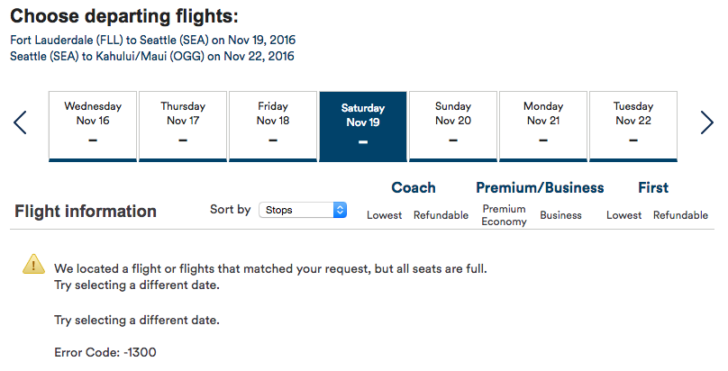
The same is true for every other leg. In fact, it appears that there is no trouble at all finding award space on these flights and on these dates. So why didn’t it work when I tried to search all at once?
My problem was that the return flight from Maui to Seattle landed at 8:59 PM, but there were no flights to Ft. Lauderdale leaving after that. The multi-city search that I ran in the beginning said I wanted to fly back to Ft. Lauderdale on the same day — one bad connection means no results.
Breaking down the search like this, looking for just one flight at a time, is time consuming but often the best way to find award inventory. It makes it easier to prioritize long haul flights, for which first or business class is more important than a short regional connection. It makes it easier to identify partner award space on the calendar.
It’s also easier to avoid complete and utter failures like the one at the beginning of this section. By adjusting one date, flying from Seattle to Ft. Lauderdale the next morning, I got all the results I wanted with no trouble at all. You can even see the stopover if you check the dates.
In conclusion, the Alaska Airlines website isn’t my favorite to work with. The loyalty program has inherent complexities built into the way it prices partner award flights that also make it difficult to search for them. The website would be vastly improved if it also enabled you to filter results to a specific carrier on the calendar page.
However, learning to use the website can still be useful to avoid the fees associated with calling a human agent, and some partners can be spotted easily if you know what to look for. It’s also fairly simple to book stopovers, which is one of the program’s best features.



